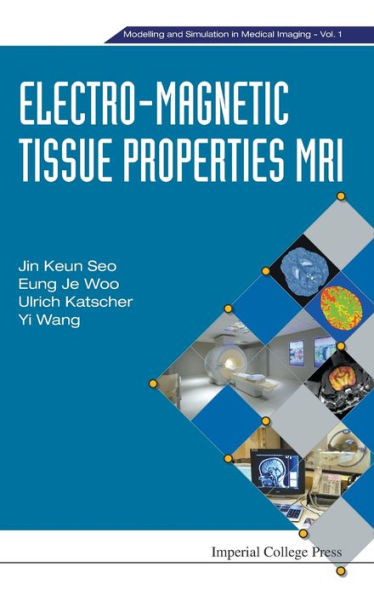Electro-magnetic Tissue Properties Mri available in Hardcover, eBook

Electro-magnetic Tissue Properties Mri
- ISBN-10:
- 1783263393
- ISBN-13:
- 9781783263394
- Pub. Date:
- 05/07/2014
- Publisher:
- Imperial College Press
- ISBN-10:
- 1783263393
- ISBN-13:
- 9781783263394
- Pub. Date:
- 05/07/2014
- Publisher:
- Imperial College Press

Electro-magnetic Tissue Properties Mri
Buy New
$108.00Overview

Product Details
| ISBN-13: | 9781783263394 |
|---|---|
| Publisher: | Imperial College Press |
| Publication date: | 05/07/2014 |
| Series: | Modelling And Simulation In Medical Imaging , #1 |
| Pages: | 296 |
| Product dimensions: | 6.00(w) x 9.10(h) x 0.90(d) |
Table of Contents
Preface v
Foreword ix
1 Introduction 1
1.1 Electro-magnetic Tissue Properties of Biological Tissues 2
1.2 Three Electro-magnetic Tissue Property Imaging Modalities 4
1.3 Mathematical Frameworks 5
1.4 General Notations 7
2 Electro-magnet ism and MRI 9
2.1 Basics of Electro-magnetism 10
2.1.1 Maxwell's equations 10
2.1.2 Electric field due to point charges in free space 11
2.1.3 Molecular polarization 16
2.1.4 Electrical bioimpedance for cylindrical subjects 17
2.1.4.1 Conductivity and resistance at direct current 17
2.1.4.2 Permittivity and capacitance 19
2.1.4.3 Admittivity of a material including both mobile and immobile charges 20
2.1.5 Boundary value problems in electrostatics 21
2.1.6 Time-harmonic Maxwell's equations and eddy current model 24
2.1.7 Magnetic field created by magnetic moment 28
2.2 Magnetic Resonance Imaging 31
2.2.1 MR signal and Larmor precession of spins ignoring relaxation effects 33
2.2.1.1 Larmor precession of M in an external field B 33
2.2.1.2 MR signal ignoring relaxation effects 36
2.2.1.3 MR signal with gradient field 37
2.2.1.4 One-dimensional imaging with frequency encoding 40
2.2.1.5 Two-dimensional imaging with phase and frequency encoding 41
2.2.2 On-resonance RF excitation to flip M toward the xy-plane 44
2.2.2.1 Time-harmonic RF field 44
2.2.2.2 Time-harmonic RF excitation and flip angle 47
2.2.3 Signal detection and RF reciprocity principle 51
2.2.3.1 RF reciprocity principle 52
2.2.4 Relaxation effects 55
2.3 Fourier Transform 56
2.4 Image Processing 59
2.4.1 Diffusion techniques for denoising: L1 vs. L2 minimization 60
2.4.2 Segmentation 63
2.4.3 Sparse sensing 67
References 71
3 Magnetic Resonance Electrical Impedance Tomography 77
3.1 Overview and History of MREIT 78
3.2 Overall Structure of MREIT 83
3.3 Measurement of Internal Data Bz 85
3.3.1 Noise analysis 88
3.3.2 Pulse sequence 91
3.4 Forward Model 92
3.4.1 Boundary value problem in MREIT 93
3.4.2 Computation of Bz 98
3.5 Uniform Current Density Electrodes 102
3.5.4 Mathematical model for uniform current electrode in half space 104
3.5.2 Optimal geometry of non-uniform recessed electrodes 105
3.6 Mathematical Model of MREIT for Stable Reconstruction 109
3.6.1 Map from σ to Bz data 109
3.6.2 Toward uniqueness of an MREIT problem 110
3.6.2.1 Scaling uncertainty of σ 111
3.6.2.2 Two linearly independent currents for uniqueness 112
3.7 MREIT with Object Rotations 114
3.7.1 Current density imaging 115
3.7.1.1 Recovering a transversal current density J having Jz - 0 using Bz 117
3.7.2 Early MREIT algorithms 119
3.7.3 J-substitution algorithm 120
3.7.3.1 J-substitution: Uniqueness 122
3.7.3.2 J-substitution algorithm: Iterative scheme 124
3.8 MREIT Without Subject Rotation 125
3.8.1 Harmonic Bz algorithm 126
3.8.1.1 Mathematical model and corresponding inverse problem 128
3.8.1.2 Two-dimensional MREIT model 129
3.8.1.3 Representation formula 133
3.8.1.4 Local reconstruction using harmonic Bz algorithm 137
3.8.1.5 Conductivity reconstructor using harmonic Bz algorithm 139
3.8.1.6 Non-iterative harmonic Bz algorithm with transversally dominant current density 143
3.8.1.7 A posteriori error estimate: two-dimensional MREIT model 147
3.8.2 Variational Bz and gradient Bz decomposition algorithm 152
3.8.2.1 Variational Bz algorithm 153
3.8.2.2 Gradient Bz decomposition algorithm 156
3.9 Anisotropic Conductivity Reconstruction Problem 158
3.9.1 Definition of effective conductivity for a cubic sample 159
3.9.2 Anisotropic conductivity reconstruction in MREIT 161
3.10 Imaging Experiments 163
3.10.1 Phantom experiment 163
3.10.1.1 Non-biological phantom imaging 163
3.10.1.2 Biological phantom imaging 166
3.10.1.3 Contrast mechanism of apparent conductivity 167
3.10.2 Animal experiment 170
3.10.2.1 Postmortem animal imaging 170
3.10.2.2 In vivo animal imaging 173
3.10.3 In vivo human imaging 178
3.10.4 Challenging problems and future directions 179
Acknowledgments 181
References 181
4 MR-EPT 191
4.1 Mathematical Model 193
4.1.1 Central EPT equation 193
4.1.2 Approximate EPT equation 196
4.1.3 Boundary effects 201
4.1.4 Anisotropy 204
4.1.5 Local SAR 206
4.2 Data Collection Method 208
4.2.1 Amplitude 209
4.2.2 Phase 209
4.3 Image Reconstruction 212
4.3.1 SNR and calculus operation kernel 212
4.3.2 Main field strength and SNR 213
4.4 Numerical Simulations 214
4.4.1 Head model 214
4.5 Experiments 217
4.5.1 Phantom experiments 217
4.5.2 Volunteer experiments 218
4.6 Medical Applications 222
4.7 Challenging Problems and Future Directions 223
Acknowledgments 224
References 225
5 Quantitative Susceptibility Mapping 231
5.1 Introduction 231
5.2 Mathematical Model for Relating MRI Signal to Tissue Susceptibility 234
5.2.1 The forward problem description 234
5.2.1.1 Formulation of the forward problem from tissue magnetization to MRI measured field 234
5.2.1.2 Inverse problem and mathematical analysis 237
5.2.1.3 Ill-poised issue of the inverse problem from measured field to magnetization source 240
5.2.2 Solutions to the inverse problem 241
5.2.2.1 Morphology enabled dipole inversion (MEDI) 241
5.2.2.2 Other forms of prior information for dipole inversion 244
5.2.2.3 Condition the inverse problem well for precise solution - Calculation of Susceptibility using Multiple Orientation Sampling (COSMOS) 245
5.3 Data Acquisition Method 247
5.4 Image Reconstruction Method 248
5.4.1 The MEDI reconstruction algorithm 248
5.4.2 Background field removal without affecting local fields 250
5.5 Numerical Simulation 251
5.6 Experimental Validation 255
5.6.1 Validation of the reference standard COSMOS method 255
5.6.2 Validation of the MEDI method 257
5.6.3 Clinical applications 260
5.6.3.1 Cerebral microhemorrhage 260
5.6.3.2 Hemorrhage 261
5.6.3.3 Deep brain stimulation 262
5.6.3.4 Parkinson's disease 263
5.6.3.5 Multiple sclerosis 264
5.7 Challenging Problems and Future Directions 266
Acknowledgments 267
References 268
Index 275
